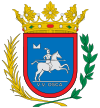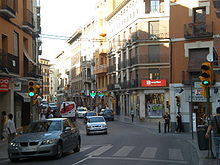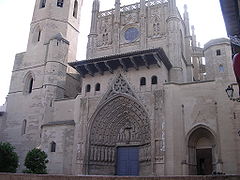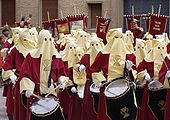- Huesca
-
Huesca
Uesca— Municipality — The city of Huesca as seen from the cathedral 
Flag
Coat of armsMotto: Gate of the Pyrenees Location in Spain Coordinates: 42°8′N 0°25′W / 42.133°N 0.417°WCoordinates: 42°8′N 0°25′W / 42.133°N 0.417°W Country  Spain
SpainAutonomous community  Aragon
AragonProvince Huesca Comarca Hoya de Huesca Judicial district Huesca Founded by Iberians Government - Type Mayor-council - Body Ayuntamiento de Huesca - Mayor Ana Alós López (2011) (PP) Area - Total 161.0 km2 (62.2 sq mi) Elevation 488 m (1,601 ft) Population (2010) - Total 52,347 - Density 325.1/km2 (842.1/sq mi) Demonym Oscense Time zone CET (UTC+1) - Summer (DST) CEST (UTC+2) Postal code 22001 - 22006 Dialing code 974 Patron Saints Saint Lawrence
Saint VincentWebsite Official website Huesca (Spanish pronunciation: [ˈweska]; Aragonese: Uesca) is a city in north-eastern Spain, within the autonomous community of Aragon. It is also the capital of the Spanish province of the same name and the comarca of Hoya de Huesca. In 2009 it had a population of 52,059, almost a quarter of the total population of the province. That makes it one of the least populated provincial capitals in Spain.
Huesca celebrates its main festivities Fiestas de San Lorenzo[1] from 9 to 15 August.
Contents
History
Huesca's pre-Roman Iberian name was Bolskan. It was the capital of the Ilergetes, in the north of Hispania Tarraconensis, on the road from Tarraco (modern Tarragona) and Ilerda (modern Lleida) to Caesaraugusta (modern Zaragoza)[2] and fell under Caesaraugusta's jurisdiction. Pliny alone[3] places the Oscenses in Vescitania, a district mentioned nowhere else[4] The city's name was rendered as Osca, and was a Roman colony, Urbs Victrix Osca, during the Roman Empire. Under the impetus of Quintus Sertorius, the renegade Roman and Iberian hero who made Osca his base, the city minted its own coinage and was the site of a prestigious school founded by Sertorius to educate young Iberians in Latin and Romanitas in general. We learn from Plutarch[5] that it was a large town, and the place where Sertorius died. It is probably the town called Ileoscan (Ἰλεόσκαν) by Strabo, in an apparently corrupt passage[6] It seems to have possessed silver mines,[7] unless the argentum Oscense here mentioned merely refers to the minted silver of the town.
18th century Spanish historian Enrique Flórez, however,[8] has pointed out the impossibility of one place supplying such vast quantities of minted silver as we find recorded in ancient writers under the terms argentum Oscense, signatum Oscense; and is of the opinion that "Oscense" in these phrases means "Spanish", being a corruption of "Eus-cara".[9]
The fully Romanised city, with its forum in the Cathedral square, was made a municipium by decree of Augustus in 30 BC. It was renamed Wasqah during the period of Arab domination, when the fortified city was a stronghold defending the frontier against the Christian counts and local kings of the Pyrenees. In 1094 Sancho Ramirez built the nearby Montearagón castle with the intention of laying siege to Wasqah; here he met his death by a stray arrow as he was reconnoitring the city's walls. It was conquered in 1096 by Peter I of Aragon.
In 1354, King Peter IV of Aragon chartered the University of Huesca, which initially had a faculty of theology. The school expanded, but by the end of the 16th century was eclipsed by the University of Zaragoza.[10] The university was abolished in 1845.[11]
During the Spanish Civil War (1936-39) the "Huesca Front" was the scene of some of the worst fighting between the Republicans and Franco's army. The city was besieged by the Republicans, George Orwell among them (see below) but never fell.
Modern Huesca
Huesca celebrates its most important annual festival in August: the festival (or fiesta) of San Lorenzo (Lawrence), a native of Huesca martyred in 268 AD. The anniversary of his martyrdom falls on August 10. The fiesta starts on 9 August and finishes on the 15. Many of the inhabitants dress in green and white for the duration of the fiesta.
San Lorenzo, born in Huesca, was a deacon in Rome and martyred by the Romans, burned on a grille (at least according to legend). Hence the grille is the symbol of San Lorenzo. It can be seen in a number of decorative works in the city.
Huesca is also the birthplace of film director Carlos Saura and his brother Antonio Saura, contemporary artist. There is an international film festival held annually.
The writer Oscar Sipan, winner of several literary prizes, was born in Huesca in 1974. The celebrated illustrator Isidro Ferrer, though born in Madrid, lives in the city.
Geography
Huesca is located in the northern region of Aragón, in a depression known as Hoya de Huesca to 488 m (1,601.05 ft) above sea level, close to the city is located the Sierra de Guara, with a height of 2.077 m. The geographical coordinates of the city are: 42° 08´ N, 0° 24´ W.
Its municipal area is 161.02 km ² and borders the municipalities of Almudévar, Vicién, Monflorite-Lascasas Tierz, Quicena, Loporzano, Nueno, Igriés, Banastás, Chimillas, Alerre, Barbués and Albero Bajo.
The city lies 71 kilometres (44 mi) from Zaragoza, 160 kilometres (99 mi) from Pamplona, 118 kilometres (73 mi) from Lérida, 380 kilometres (236 mi) from Madrid and 273 kilometres (169 mi) from Barcelona.
Climate
Huesca has a mediterranean climate (Köppen climate classification Csa), with drier summers, and wetter springs and autumns, but with some characteristics of a continental climate, such as more extreme temperatures, as the town lies in a wide basin (the Ebro basin) entirely surrounded by mountains.
The average precipitation is a scanty 550 mm. There is drought in summer. The temperatures are high in summer reaching up to 35 °C (95 °F). In winter the temperatures are to low (usually -5 to 8 °C). Frost is common and there is sporadic snowfall.
Climate data for Huesca Month Jan Feb Mar Apr May Jun Jul Aug Sep Oct Nov Dec Year Average high °C (°F) 8.5
(47.3)11.5
(52.7)15
(59)17.2
(63.0)21.2
(70.2)26.5
(79.7)30.8
(87.4)30.2
(86.4)25.5
(77.9)19.1
(66.4)12.9
(55.2)9.1
(48.4)19.0 Daily mean °C (°F) 4.9
(40.8)7.0
(44.6)9.6
(49.3)11.4
(52.5)15.3
(59.5)19.7
(67.5)23.4
(74.1)23.3
(73.9)19.5
(67.1)14.3
(57.7)8.9
(48.0)5.6
(42.1)13.6 Average low °C (°F) 1.3
(34.3)2.5
(36.5)4.2
(39.6)5.7
(42.3)9.3
(48.7)12.9
(55.2)16.1
(61.0)16.3
(61.3)13.5
(56.3)9.5
(49.1)4.9
(40.8)2.1
(35.8)8.2 Precipitation mm (inches) 39
(1.54)32
(1.26)34
(1.34)53
(2.09)62
(2.44)47
(1.85)20
(0.79)38
(1.5)54
(2.13)54
(2.13)50
(1.97)51
(2.01)535
(21.06)Avg. precipitation days (≥ 1 mm) 6 5 4 6 8 5 3 4 4 6 5 5 62 Sunshine hours 131 169 220 245 265 298 339 310 241 197 144 113 2,682 Source: AEMET[12] Main sights
A double line of ancient walls can still be seen in present-day Huesca.
Nearby, in the territory of Quicena, are the ruins of the Monastery-Castle of Montearagón.
Churches of Huesca
- Huesca Cathedral (Catedral de la Transfiguración del Señor) in Gothic style begun by king James I of Aragon around 1273 on the ruined foundations of the mosque. Work continued until the fifteenth century, creating one of the architectural landmarks of northern Spain. The doorway of 1300-1313 has carvings depicting the Apostles. The interior contains a triple nave and lateral chapels. It includes a magnificent high altar of alabaster carved to represent the Passion, made in 1520-1533 by Damián Forment. The cloister and the bell-tower are from the fifteenth century.
- Monastery of San Pedro el Viejo, erected between 1100 and 1241, is one of the oldest Romanesque structures in the Peninsula. It was rebuilt in the seventeenth century, but retains its cloister of 1140.
- Church of St. Lawrence (Iglesia de San Lorenzo), seventeenth and eighteenth centuries.
- Iglesia de Santo Domingo, in Baroque style.
- Iglesia de la Compañía San Vicente (17th century)
- Ermita de Ntr. Sra. de Salas, Romanesque and Baroque
- Ermita de Loreto, San Lorenzo's cradle according to tradition.
- Ermita de San Jorge, in memory of the Battle of Alcoraz
- Ermita de las Mártires
- Ermita de Santa Lucía
- Ermita de Jara, in ruins
- San Miguel, Romanesque tower
- Santa María de Foris, in transition Romanesque style
- Santa Cruz, Seminary, on Romanesque foundations.
- There are several old monasteries in the immediate neighbourhood. The one in Castle of Montearagón contains in its crypt the tomb of king Alfonso I of Aragon.
- The institute for secondary education occupies the building formerly belonging to the old university. In one of its vaults is the famous "Bell of Huesca", said to have been constructed from the heads of insurgent nobles who were executed by King Ramiro II of Aragon.
Popular references
Huesca is notable for the saying "Tomorrow we'll have coffee in Huesca", a running joke among militiamen of the Spanish Civil War. In February 1937, George Orwell was stationed near the falangist-held Huesca as a member of the POUM militia. In Homage to Catalonia, Orwell writes about this running joke, originally a naïvely optimistic comment made by one of the Spanish Republican generals:
Months earlier, when Siétamo was taken, the general commanding the Government troops had said gaily: "Tomorrow we'll have coffee in Huesca." It turned out that he was mistaken. There had been bloody attacks, but the town did not fall, and [the phrase] had become a standing joke throughout the army. If I ever go back to Spain I shall make a point of having a cup of coffee in Huesca.
Orwell never did: but the Indian writer Shashi Tharoor fulfilled his wish, on his behalf, in 1980, and has written about the experience.[13] Huesca is also famous for the legend of the Bell of Huesca.
Twin towns - sister cities
The following are Sister cities of Huesca:[14]
See also
- Diocese of Huesca
- SD Huesca
References
- ^ Fiestassanlorenzo.es
- ^ Antonine Itinerary pp. 391, 451.
- ^ iii. 3. s. 4.
- ^ Pliny, in the Third Book of Naturalis Historia. Translation at penelope.uchicago.edu
- ^ Sert. c. 14.
- ^ iii. p. 161; v. Friedrich August Ukert, vol. ii. pt. 1. p. 451.
- ^ Livy xxxiv. 10, 46, xl. 43.
- ^ Med. ii. 520.
- ^ Cf. Julius Caesar Commentarii de Bello Civili i. 60; Velleius Paterculus ii. 30; "Euskara", Basque for the Basque language.
- ^ Hastings Rashdall,The universities of Europe in the middle ages, Volume 2, Part 1, Oxford, 1895, pp. 92-94.
- ^ Hans Hoefe & Andrew Eames, Spain, 2d ed 1993, p. 305.
- ^ "Valores Climatológicos Normales. Huesca / Aeropuerto". http://www.aemet.es/es/elclima/datosclimatologicos/valoresclimatologicos?l=9898&k=arn.
- ^ tharoor.in
- ^ "Cities twinned with Huesca. Huesca City Hall". Huesca.es. http://www.huesca.es/areas/fiestas/hermanamiento-de-tarbes/. Retrieved 2011-07-05.
Sources
- Michael H. Crawford, 1985. Coinage and Money Under the Roman Republic in series Library of Numismatics (London: Methuen and Co. Ltd.), pages 84 - 102.
 This article incorporates text from a publication now in the public domain: Smith, William, ed (1854–57). "article name needed". Dictionary of Greek and Roman Geography. London: John Murray.
This article incorporates text from a publication now in the public domain: Smith, William, ed (1854–57). "article name needed". Dictionary of Greek and Roman Geography. London: John Murray.
External links
- Council of Huesca (Spanish)
- Huesca Film Festival
- Diario Del Alto Aragón (Spanish)
- Virtual Tour around Huesca
- Excursiones por Huesca (Spanish)
- Fiestas de San Lorenzo (Spanish)
Capitals of provinces of Spain A Coruña · Albacete · Alicante · Almería · Ávila · Badajoz · Barcelona · Bilbao · Burgos · Cáceres · Cádiz · Castellón de la Plana · Ciudad Real · Córdoba · Cuenca · Donostia-San Sebastián · Girona · Granada · Guadalajara · Huelva · Huesca · Jaén · Logroño · Las Palmas de Gran Canaria · León · Lleida · Lugo · Madrid · Málaga · Murcia · Ourense · Oviedo · Palencia · Palma · Pamplona · Pontevedra · Salamanca · Santander · Santa Cruz · Segovia · Seville · Soria · Tarragona · Teruel · Toledo · Valencia · Valladolid · Vitoria-Gasteiz · Zamora · Zaragoza Categories:
Categories:- Ancient mints
- Municipalities in Huesca
- Roman sites in Spain
- Populated places in Huesca
Wikimedia Foundation. 2010.









